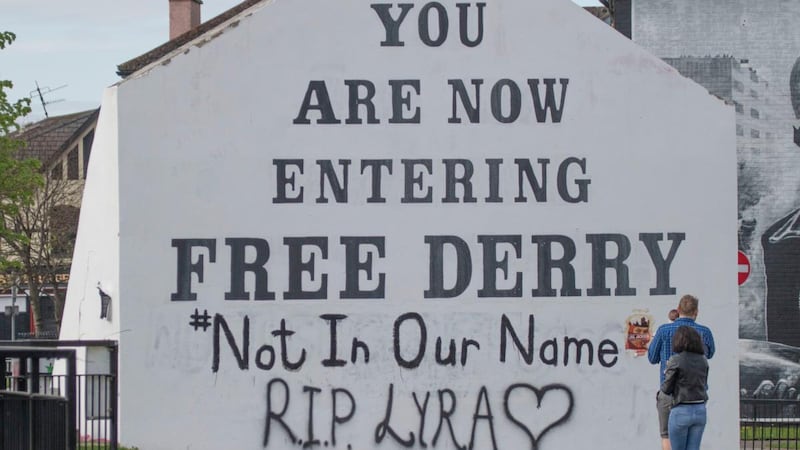In 2007, Fionola Meredith quoted Lyra McKee in a piece in The Irish Times when Lyra was just 17, writing for a BBC website about her participation in a youth journalism project, “The strain of the past 11 days plunged me into a zombie-like stupor . . . Even with all this, I can still honestly say, wait till I cross my fingers, that I love being a journalist. Turning out a great piece of work even when time is running against you is like sticking your tongue out and saying, ‘Ha ha, look what I can do!’”
Within that statement is everything that journalism can hold for a young person with a natural disposition towards the job; the rush of excitement the work can deliver and revelling in the energy-sapping process, the love-hate relationship with deadlines, and the self-assuredness the prospect of accomplishment offers. This is a person whose gravitation towards journalism was vocational in its drive.
I think many journalists will recognise the vigour in her sentiment, the energy that bright sparks bring when they strut into a newsroom or josh with their colleagues at a marking or get in touch offering encouragement and solidarity, as Lyra often did, including to myself.
Over the weekend, social media flooded with stories of how often she reached out to people, and how many friends she had in journalism, across outlets.
Personal adversity
Reading about how motivated Lyra was, it’s clear that purpose was there from the start. Her chosen area of investigative journalism is without doubt the hardest avenue to go down in the industry.
There is little superficiality, ego or self-promotion involved. Lyra overcame the personal adversity of her sexuality to carve out a future for herself, “I hated myself for much of my life because of what religion taught me about people like me,” she said in her TEDx talk about the impact of religious teaching on LGBT people.
“Within the LGBT community, we have a saying, we tell them It Gets Better . . . It gets better for those of us who live long enough to see it get better.”
Pull back the gauze of violence that so frequently unfurls on this part of our island over old wounds, and ask why
I can’t help but think that if another journalist had been shot on Thursday night, what Lyra would have thought and felt. What would her impulse be? It would probably be to look for answers. Not just the facts of the situation, but to pull back the gauze of violence that so frequently unfurls on this part of our island over old wounds, and ask why? Why is this happening?
Why does violence so easily, almost naturally, fill these vacuums time and time again, even when those perpetrating it were brought up in so-called peacetime? Lyra wrote extensively about the trauma that reverberates in the North and how the legacy of violence articulates itself in contemporary lives.
Some see the scar tissue that formed over society in the North in the wake of the ceasefires and the Belfast Agreement as radioactive, others see a pathway to repetition.

Police believe that the two teenagers, aged 18 and 19, arrested in connection with the shooting, are members of the so-called New IRA. These young men weren’t even born when the Belfast Agreement was signed.
They were born in the 21st century. In attempting to imagine a purpose, their imagination reverted to conjuring the ghosts of the past. Who stoked their rage? Who put the gun in the hands of a teenager? And to what end? For death. For horror.
Poverty and trauma
Sinéad O'Shea spent five years making a documentary in Derry called A Mother Brings Her Son To Be Shot.
As she wrote in the Guardian, one of the boys she interviewed for the documentary told her that people his age wanted the Troubles to return, even though they had never witnessed them firsthand: “The madness, the riots, the shootings, the bombings, everything.”
All around the world, in communities underscored by poverty and trauma, the result is often violence among young men. The mask might change – gang violence, terrorism – but the outcome is the same.
All around the world, in communities underscored by poverty and trauma, the result is often violence among young men
The social changes in Northern Ireland over the last 20 years have been huge. Belfast has transformed, but places like Derry are on something of a bungee cord, running forward with some degree of resistance before being yanked back by the regressive, violent, irresponsible, reckless actions of others. It’s a place where most young people cannot imagine fulfilling their purpose.
In 2017, a Youth Exodus survey found that 87 per cent of young people living in Derry didn’t see a future for themselves there. Some 84 per cent said they would not consider moving back to Derry after leaving. The majority said their reason for leaving was a lack of job opportunities. A pilot survey put the figure of young people who didn’t see a future for themselves in Derry at 95 per cent.
A generation cannot be categorised as homogenous. Many young people in the North have been optimistic self-starters and created networks of solidarity along non-sectarian lines, particularly in the movements for marriage equality and reproductive rights. But the trauma is not past tense. It has become intergenerational.
No matter how literate young people are in the language of reconciliation, without purpose, regression occurs, back to the most familiar setting, even if that setting is utterly destructive, and even if they weren’t around for its origins.
Lyra McKee imagined the future. She was a role model. It’s in her spirit of optimism, integrity, humour and goodness that things must move ahead.





